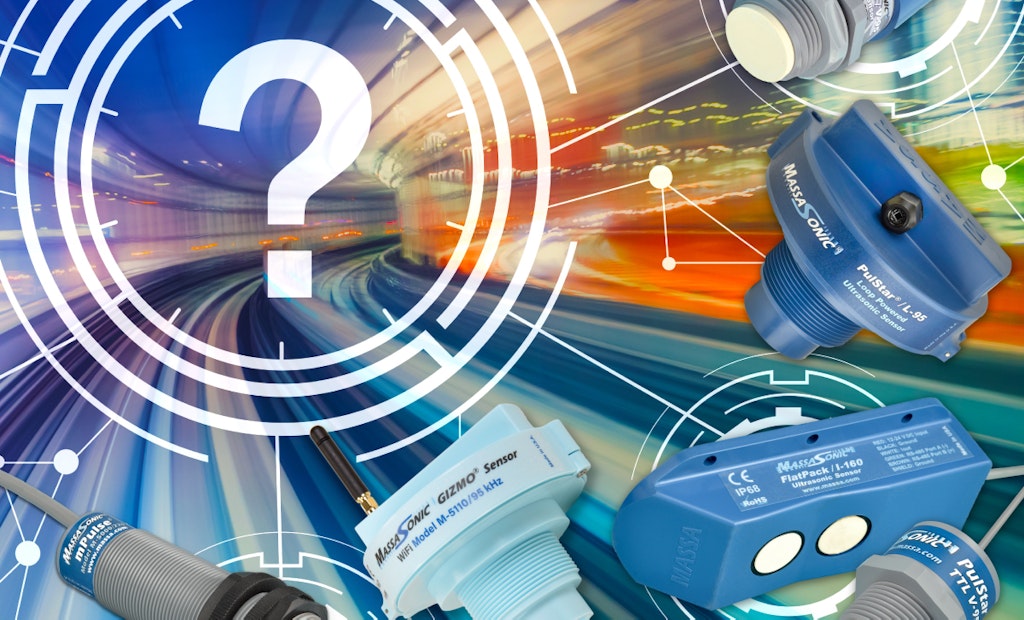Interested in Flow Control?
Get Flow Control articles, news and videos right in your inbox! Sign up now.
Flow Control + Get AlertsWhat are electroacoustics?
Electroacoustics cover a broad base of technology regarding the transmitting and receiving of sound, and include sonar and ultrasonic transducers and systems. In this type of technology, the electroacoustic transducer converts sound energy to electricity, electricity into sound, or both. The electroacoustic system includes a transducer or transducers and electronics for processing. An electroacoustic system can be a sensor alone or multiple sensors connected with processing systems of various types and magnitudes.
What's the difference between SONAR and ultrasonics?
Not a whole lot. Sonar stands for sound navigation and ranging. It is the same meaning whether the technology is used in air, underwater or other mediums. However, people usually think of ultrasonics for use in air and sonar for use underwater. The ultrasonic range is usually higher in frequency than the range of human hearing, above 20,000 Hz.
What are ultrasonic sensors?
Ultrasonic sensors are highly accurate and robust instruments for use in a variety of sensing applications. The very first ultrasonic sensing devices to measure distance in air can be traced back to Massa. An ultrasonic sensor is an electroacoustic system that combines a transducer or transducers with electronics. Ultrasonic sensors, when housed within robust materials, are able to withstand caustic environments.
The transducers within ultrasonic sensors can be transmitters of sound pressure, receivers of sound pressure, or they can do both — this in turn allows for distance measurements, and this process is called echolocation. The most reliable sensors and systems contain transducers that are optimized for the specific application.
How do ultrasonic sensors work?
Ultrasonic sensors calculate distance by using echolocation. The sensor does this by transmitting an acoustic signal toward a target and recording the time it takes to receive the echo after it bounces off the target and reflects back to the sensor. However, the time it takes for sound waves to travel through air, water or different gases varies greatly. This means each sensor must be developed properly to ensure concise and accurate measurements can be obtained with respect to the specific medium through which the sound will travel.
Are ultrasonic sensors more dependable than products that use other technologies?
They certainly can be. Depending on the environment and the application, a misconception is that ultrasonics might not work as well. In over 75 years of design and manufacturing experience, Massa has found that electroacoustic performance is greatly dependent upon the understanding of what design fits best to any given application. It's not the technology, the beam angle, the frequency, the mounting or the housing alone — it's the proper configuration of all of those things for any given application.
How do I integrate an ultrasonic sensor into my application?
Massa's engineering team takes a hands-on approach to ensure seamless integration to meet customer requirements. By holding a series of informational sessions between your team and its engineering, sales and marketing departments, Massa works to deliver results that exceed expectations. Once your solution has been determined, Massa's transparent approach keeps the customer informed throughout production and installation.
When would I use an ultrasonic sensor?
Ultrasonic products are great to try regardless of your application; however, they are an even more ideal solution when used in dark, wet, dirty and caustic environments. Ultrasonic technology is the favored solution for distance measurement, and is used for a variety of applications such as water level sensing, factory automation, autonomous driving, sub-bottom profiling and much more.
Am I able to monitor data remotely?
Yes. Massa has recently developed a highly durable and reliable family of battery-operated, top quality ultrasonic sensors that have IoT compatibility and communicate using Wi-Fi, cellular or LoRa protocols.
What if I don't know how to integrate an ultrasonic sensor into my application?
This is where Massa separates itself from the competition. Massa engineers work directly with customers to ensure they have the right sensor for their application. Once the sensor has been selected, Massa assists the customer all the way through proper setup and installation.
What if I need a customized sensor, but I have had issues with ultrasonics and other technologies in the past?
Massa specializes in designing custom sensors for unique applications. In its 75 years of experience, Massa has designed over 1,000 different transducers and sensors. Massa guarantees it can add the features you need in order to maximize accuracy and efficiency in your application.
Also please visit massa.com for more information.





